
The Lindisfarne Gospels is an illuminated manuscript gospel book probably produced around the years 715–720 in the monastery at Lindisfarne, off the coast of Northumberland, which is now in the British Library in London. The manuscript is one of the finest works in the unique style of Hiberno-Saxon or Insular art, combining Mediterranean, Anglo-Saxon and Celtic elements.

The Book of Kells is an illuminated manuscript and Celtic Gospel book in Latin, containing the four Gospels of the New Testament together with various prefatory texts and tables. It was created in a Columban monastery in either Ireland or Scotland, and may have had contributions from various Columban institutions from each of these areas. It is believed to have been created c. 800 AD. The text of the Gospels is largely drawn from the Vulgate, although it also includes several passages drawn from the earlier versions of the Bible known as the Vetus Latina. It is regarded as a masterwork of Western calligraphy and the pinnacle of Insular illumination. The manuscript takes its name from the Abbey of Kells, County Meath, which was its home for centuries.

The Book of Durrow is an illuminated manuscript dated to c. 700 that consists of text from the four Gospels gospel books, written in an Irish adaption of Vulgate Latin, and illustrated in the Insular script style.
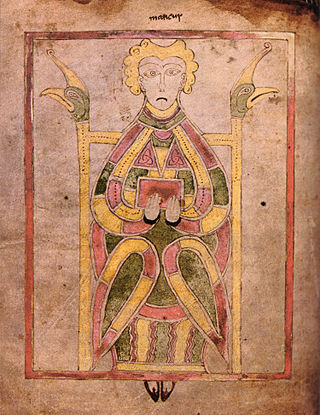
The Book of Dimma is an 8th-century Irish pocket Gospel Book originally from the Abbey of Roscrea, founded by St. Crónán in County Tipperary, Ireland. In addition to the Gospels of Luke and John, it has an order for the Unction and Communion of the Sick. The surviving illumination of the manuscript contains a number of illuminated initials, three Evangelist portrait pages, and one page with an Evangelist's symbol. The pocket gospel book is a distinctively Insular format, of which the Stowe Missal and Book of Mulling are other leading examples.

The Book of Mulling or less commonly, Book of Moling, is an Irish pocket Gospel Book from the late 8th or early 9th century. The text collection includes the four Gospels, a liturgical service which includes the "Apostles' Creed", and in the colophon, a supposed plan of St. Moling's monastery enclosed by two concentric circles.

The Hereford Gospels is an 8th-century illuminated manuscript gospel book in insular script (minuscule), with large illuminated initials in the Insular style. This is a very late Anglo-Saxon gospel book, which shares a distinctive style with the Caligula Troper. An added text suggests this was in the diocese of Hereford in the 11th century.
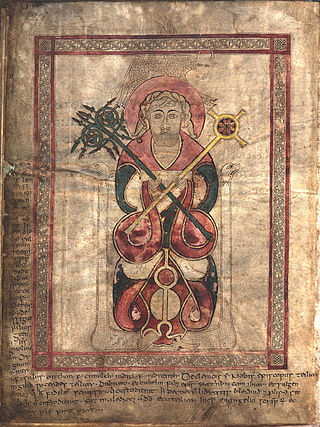
The Lichfield Gospels is an 8th-century Insular Gospel Book housed in Lichfield Cathedral. There are 236 surviving pages, eight of which are illuminated. Another four contain framed text. The pages measure 30.8 cm by 23.5 cm. The manuscript is also important because it includes, as marginalia, some of the earliest known examples of written Old Welsh, dating to the early part of the 8th century. The art historian Peter Lord dates the book at 730, placing it chronologically before the Book of Kells but after the Lindisfarne Gospels.

The Echternach Gospels were produced, presumably, at Lindisfarne Abbey in Northumbria around the year 690. This location was very significant for the production of Insular manuscripts, such as the Durham Gospels and the Lindisfarne Gospels. The scribe of the Durham Gospels is believed to have created the Echternach Gospels as well. The Echternach Gospels are now in the collection of France's Bibliothèque Nationale in Paris.

Insular script is a medieval script system originating from Ireland that spread to England and continental Europe under the influence of Irish Christianity. Irish missionaries took the script to continental Europe, where they founded monasteries such as Bobbio. The scripts were also used in monasteries like Fulda, which were influenced by English missionaries. They are associated with Insular art, of which most surviving examples are illuminated manuscripts. It greatly influenced modern Gaelic type and handwriting.
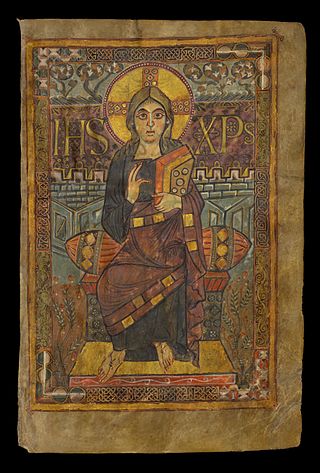
The Godescalc Evangelistary, Godescalc Sacramentary, Godescalc Gospels, or Godescalc Gospel Lectionary is an illuminated manuscript in Latin made by the Frankish scribe Godescalc and today kept in the Bibliothèque nationale de France. It was commissioned by the Carolingian king Charlemagne and his wife Hildegard on October 7, 781 and completed on April 30, 783. The Evangelistary is the earliest known manuscript produced at the scriptorium in Charlemagne's Court School in Aachen. The manuscript was intended to commemorate Charlemagne's march to Italy, his meeting with Pope Adrian I, and the baptism of his son Pepin. The crediting of the work to Godescalc and the details of Charlemagne's march are contained in the manuscript's dedication poem.

The Vespasian Psalter is an Anglo-Saxon illuminated psalter decorated in a partly Insular style produced in the second or third quarter of the 8th century. It contains an interlinear gloss in Old English which is the oldest extant English translation of any portion of the Bible. It was produced in southern England, perhaps in St. Augustine's Abbey or Christ Church, Canterbury or Minster-in-Thanet, and is the earliest illuminated manuscript produced in "Southumbria" to survive.
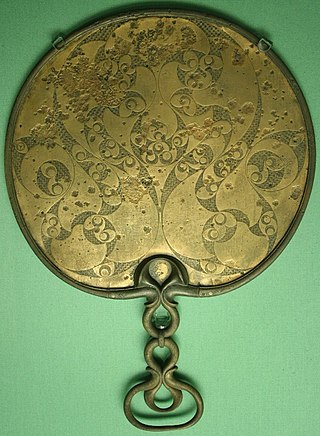
Celtic art is associated with the peoples known as Celts; those who spoke the Celtic languages in Europe from pre-history through to the modern period, as well as the art of ancient peoples whose language is uncertain, but have cultural and stylistic similarities with speakers of Celtic languages.

Migration Period art denotes the artwork of the Germanic peoples during the Migration period. It includes the Migration art of the Germanic tribes on the continent, as well the start of the Insular art or Hiberno-Saxon art of the Anglo-Saxon and Celtic fusion in Britain and Ireland. It covers many different styles of art including the polychrome style and the animal style. After Christianization, Migration Period art developed into various schools of Early Medieval art in Western Europe which are normally classified by region, such as Anglo-Saxon art and Carolingian art, before the continent-wide styles of Romanesque art and finally Gothic art developed.

Carolingian art comes from the Frankish Empire in the period of roughly 120 years from about 780 to 900—during the reign of Charlemagne and his immediate heirs—popularly known as the Carolingian Renaissance. The art was produced by and for the court circle and a group of important monasteries under Imperial patronage; survivals from outside this charmed circle show a considerable drop in quality of workmanship and sophistication of design. The art was produced in several centres in what are now France, Germany, Austria, northern Italy and the Low Countries, and received considerable influence, via continental mission centres, from the Insular art of the British Isles, as well as a number of Byzantine artists who appear to have been resident in Carolingian centres.

British Library, Egerton MS 609 is a Breton Gospel Book from the late or third quarter of the ninth century. It was created in France, though the exact location is unknown. The large decorative letters which form the beginning of each Gospel are similar to the letters found in Carolingian manuscripts, but the decoration of these letters is closer to that found in insular manuscripts, such as the Book of Kells and the Lindisfarne Gospels. However, the decoration in the Breton Gospel Book is simpler and more geometric in form than that found in the Insular manuscripts. The manuscript contains the Latin text of St Jerome's letter to Pope Damasus, St. Jerome's commentary on Matthew, and the four Gospels, along with prefatory material and canon tables. This manuscript is part of the Egerton Collection in the British Library.
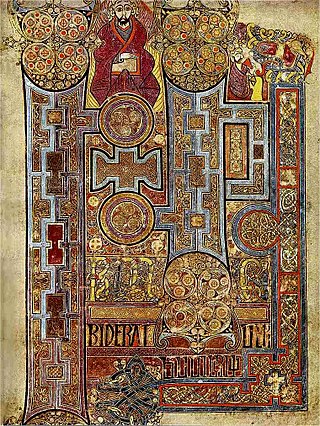
Insular art, also known as Hiberno-Saxon art, was produced in the post-Roman era of Great Britain and Ireland. The term derives from insula, the Latin term for "island"; in this period Britain and Ireland shared a largely common style different from that of the rest of Europe. Art historians usually group Insular art as part of the Migration Period art movement as well as Early Medieval Western art, and it is the combination of these two traditions that gives the style its special character.

In the visual arts, interlace is a decorative element found in medieval art. In interlace, bands or portions of other motifs are looped, braided, and knotted in complex geometric patterns, often to fill a space. Interlacing is common in the Migration period art of Northern Europe, in the early medieval Insular art of Ireland and the British Isles, and Norse art of the Early Middle Ages, and in Islamic art.

The Lindau Gospels is an illuminated manuscript in the Morgan Library in New York, which is important for its illuminated text, but still more so for its treasure binding, or metalwork covers, which are of different periods. The oldest element of the book is what is now the back cover, which was probably produced in the later 8th century in modern Austria, but in the context of missionary settlements from Britain or Ireland, as the style is that of the Insular art of the British Isles. The upper cover is late Carolingian work of about 880, and the text of the gospel book itself was written and decorated at the Abbey of Saint Gall around the same time, or slightly later.

Insular illumination refers to the production of illuminated manuscripts in the monasteries of Ireland and Great Britain between the 6th and 9th centuries, as well as in monasteries under their influence on continental Europe. It is characterised by decoration strongly influenced by metalwork, the constant use of interlacing, and the importance assigned to calligraphy. The most celebrated books of this sort are largely gospel books. Around sixty manuscripts are known from this period.


















